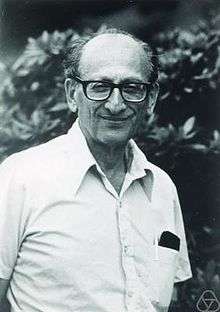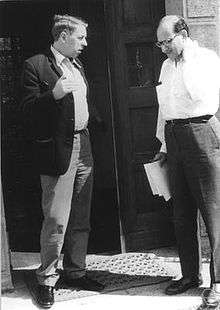Emil Grosswald
| Emil Grosswald | |
|---|---|
 | |
| Born |
December 15, 1912 Bucharest, Romania |
| Died | April 11, 1989 (aged 76) |
| Fields | Mathematics |
| Institutions |
University of Pennsylvania Temple University |
| Alma mater |
University of Bucharest University of Pennsylvania |
| Doctoral advisor | Hans Rademacher |
| Doctoral students |
David Bressoud Jean-Marie De Koninck |
Emil Grosswald (December 15, 1912 – April 11, 1989) was a Romanian-American mathematician who worked primarily in number theory. His career is closely associated with that of his teacher, Hans Rademacher.
Life and education

Grosswald was born on December 15, 1912 in Bucharest, Romania. He received a Master's degree from the University of Bucharest in 1933.[1]
Grosswald was Jewish, and fled from the Nazis to Paris in the late 1930s, then to Orléans, then through Spain to Cuba where he spent the rest of World War II. He moved to Puerto Rico in 1946 and then to the United States in 1948. He received his PhD under Hans Rademacher from the University of Pennsylvania in 1950.[2]
Grosswald died April 11, 1989 in Narberth, Pennsylvania.[1]
Career
Grosswald's first three scientific papers, written while he was in Cuba, were published under the pseudonym E. G. Garnea.[3]:11
After receiving his PhD in 1950, Grosswald taught at the University of Pennsylvania from 1952 to 1968 and then moved to Temple University and stayed until his retirement in 1980. He also held positions at the University of Saskatchewan (1950), Institute for Advanced Study (1951), the Technion (1980–1981), Swarthmore College (1982), and the University of Pennsylvania (1984).[1]
Grosswald completed some works of his teacher Hans Rademacher, who died in 1969. Rademacher had prepared notes for an Earle Raymond Hedrick Lecture in Boulder, Colorado in 1963 on Dedekind sums, but fell ill, and Grosswald gave the lecture for him.[4] After Rademacher's death, Grosswald edited and completed the notes and published them in the Carus Mathematical Monographs series as Dedekind Sums.[5]:214 He also edited for publication Rademacher's posthumous textbook Topics in Analytic Number Theory.[1]
Grosswald was elected to the Board of Governors of the Mathematical Association of America for 1965–1968.[6] Temple University's Mathematics Department annually sponsors the Emil Grosswald Memorial Lectures.[7]
Selected publications
- Grosswald, Emil; Rademacher, Hans (1972). Dedekind Sums. Carus Mathematical Monographs. 16. Washington, DC: Mathematical Association of America. ISBN 978-0-88385-016-9.
- Rademacher, Hans (1973). Grosswald, Emil; Lehner, Joseph; Newman, Morris, eds. Topics in Analytic Number Theory. Grundlehren der mathematischen Wissenschaften. 169. Berlin: Springer-Verlag. ISBN 978-0-387-05447-6.
- Rademacher, Hans (1974). Grosswald, Emil, ed. Collected Papers of Hans Rademacher. vol. 1. Cambridge: MIT Press. ISBN 978-0-262-07055-3.(View 2nd volume.). vol. 2. ISBN 0-262-07055-3.
- Grosswald, Emil (1978). Bessel Polynomials. Berlin: Springer-Verlag. ISBN 978-0-387-09104-4.[8]
- Grosswald, Emil (2008) [1984]. Topics from the Theory of Numbers (2nd ed.). Cambridge: Birkhäuser Boston. ISBN 978-0-8176-4837-4.
- Grosswald, Emil (1985). Representations of Integers as Sums of Squares. Berlin: Springer-Verlag. ISBN 978-0-387-96126-2.
Notes
- 1 2 3 4 "A Guide to the Emil Grosswald Papers, 1942–1988". University of Texas. Retrieved 2009-02-06.
- ↑ Knopp, Marvin I. (July–August 1989). "Emil Grosswald 1912–1989". Notices of the American Mathematical Society. 36 (6): 685–686. Retrieved 2009-02-06.
- ↑ American Mathematical Society. Marvin Knopp ..., ed. (1993). Knopp, Marvin; Sheingorn, Mark, eds. A Tribute to Emil Grosswald. Providence: American Mathematical Society. ISBN 978-0-8218-5155-5. Retrieved 2009-02-06.
- ↑ "Hans Rademacher Collection 1942–1963" (PDF). American Philosophical Society. 2003-08-07. Archived from the original (PDF) on October 15, 2007. Retrieved 2009-02-07.
- ↑ Berndt, Bruce C. (1992). "Hans Rademacher (1892–1969)" (PDF). Acta Arithmetica. 61: 209–231. Retrieved 2009-02-07.
- ↑ Hailpern, Raoul (August–September 1965). "New Sectional Governors of the Association". American Mathematical Monthly. 72 (7): 813. JSTOR 2314478.
- ↑ "Department of Mathematics : Grosswald Lectures". Temple University. 2010-04-20. Retrieved 2009-02-07.
- ↑ Boas, R.P. (1979). "Review: Emil Grosswald, Bessel polynomials". Bull. Amer. Math. Soc. (N.S.). 1 (5): 799–800. doi:10.1090/s0273-0979-1979-14678-0.
Further reading
- American Mathematical Society. Marvin Knopp ..., ed. (1993). Knopp, Marvin; Sheingorn, Mark, eds. A Tribute to Emil Grosswald. Providence: American Mathematical Society. ISBN 978-0-8218-5155-5. Retrieved 2009-02-06. A set of papers in honor of Grosswald; includes reminiscences, list of PhD students, and a list of papers and books.
External links
- Emil Grosswald at the Mathematics Genealogy Project
- O'Connor, John J.; Robertson, Edmund F., "Emil Grosswald", MacTutor History of Mathematics archive, University of St Andrews.